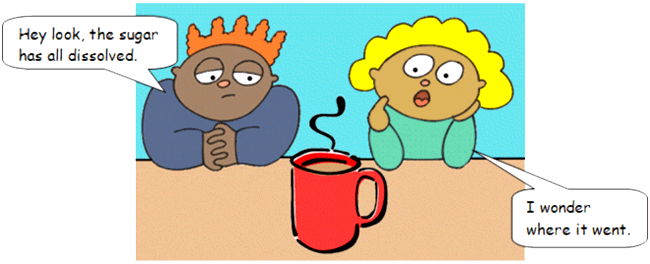Dissolving sugar

- the conventions of diagrams and how they clarify the meaning for the reader.
- the advantages and disadvantages of using diagrams to communicate science information.
- that labels clarify a diagram’s message.
| Y4 (08/2007) | Y10 (08/2007) | |
Levels of response:
|
The most common response was a drawing showing that the sugar had gone (67%). |
The most common response was a drawing showing that the sugar had gone (about 40%). About 30% showed the sugar mixing into the liquid. |
Change and constancy has been described as one of the unifying ideas of science, and understanding the structure of matter is really important for understanding how our world works. "Descriptions of change are important for predicting what will happen; analysis of change is essential for understanding what is going on, as well as for predicting what will happen; and control of change is essential for the design of technological systems" (American Association for the Advancement of Science, 1990).
Dissolving is a physical change of state, along with evaporating, condensing, melting, and freezing. However, it is more complex than other changes of state because it involves two substances, the solute (the substance being dissolved) and the solvent (the substance the solute dissolves into).

The key competency, Using language, symbols, and texts, and the nature of science strand, Communicating in science, are potentially strengthened through this activity. Drawing can be an effective way of communicating complex science ideas. Scientists have particular agreed conventions they use to model the structure and behaviour of materials at the micro level. Students can learn about these conventions, enabling them to both read scientific texts, and use the conventions to communicate their own understandings.

An analysis of students' drawings indicated little difference between Year 4 and Year 10 students being able to show through drawing the process of dissolving at a particle level. This is despite the fact that Year 10 students are likely to have encountered particle theory during their science lessons, whereas Year 4 students' focus is likely to have been at the level of observable changes. There are a number of factors that may have led to this.
- Year 4 students were more comfortable with drawing about what they knew, whereas many Year 10 students felt threatened. "I can't draw" or "How can you show dissolving in a drawing?" were two common responses from the older students.
- Conversations with students suggest younger students appeared to recognise the cue of the magnifying glass better than the older students, even though they didn't have the background knowledge to be able to show particles.
- In learning about particle theory students may not have been exposed to ways that scientists represent particles and their behaviour.
- Dissolving is a very difficult concept to understand at a particle level.
The graph does illustrate that, even though their drawings still showed what was observable, Year 10 students had progressed from thinking that the sugar was gone. It is worth noting that students who added labels to their diagrams were more likely to provide evidence of this.
Although students' drawings may not have provided evidence of understanding at a particle level, this does not necessarily mean they do not have that understanding.
| Misconceptions | Comment |
| Confused dissolving with other processes (usually melting) | This is a common vocabulary issue. About 14% of both Year 4 and Year 10 trial students had issues with this. |
| Three year 10 students tried to use an equation to describe dissolving. |
These responses indicated that a formula had been learnt without understanding what it represented. This is a useful reminder that ideas can be represented at 3 levels:
Students need to be able to understand at the macro and micro level before they are introduced to symbolic representations. |
| For common misconceptions about dissolving go to Why "dissolving" is a difficult idea | |
Extending ideas about dissolving
- Provide lots of opportunities to observe examples of dissolving, explore their own questions, and discuss their theories with peers. For some ideas for activities go to Further resources.
- Introduce particle theory gradually. Role play is a strategy that can be used as an introduction to how particles behave. Asking students to perform their own role play may also highlight misconceptions.
Extending ideas about communicating in science
- Provide opportunities for students to show their understanding in a variety of ways.
- Before introducing scientists' ways of communicating ask students to come up with their ways of modelling the unseen.
- Critically examine different representations. What is being shown in this diagram? Why might it be represented in this way? What is not being shown? What is the role of labels in diagrams? What can a diagram or model communicate that written text cannot?
Exemplars:
- This Level 5 exemplar shows a student's progress in using representations to describe the nature of matter: It's elementary
On the Science IS site there are two activities that explore scientists' representations of atoms:
- Level 5-8, Models of the atom from Democritus to Rutherford
- Level 5, Selecting models of atoms
Ministry of Education (2001). Building Science Concepts, Book 16. Sand, Salt, and Jelly Crystals, Wellington: Learning Media.
Ministry of Education (1998). Making better sense of the material world. Wellington: Learning Media. Refer to the chapter Drinks.

